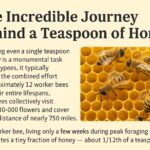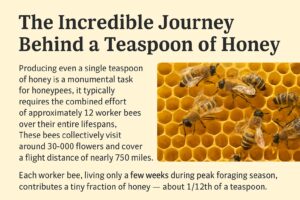The Incredible Journey Behind a Teaspoon of Honey: Why Every Drop Matters
When you drizzle honey into your tea or spread it on warm toast, it’s easy to forget the astonishing story behind every golden drop. Producing even a single teaspoon of honey is one of nature’s most remarkable feats — a process powered by thousands of wingbeats, countless flower visits, and the unwavering dedication of honeybees.
How Many Bees Does It Take to Make a Teaspoon of Honey?
It may surprise you to learn that it takes the combined lifetime effort of about 12 worker bees to produce just one teaspoon of honey. These tiny insects, each weighing less than a tenth of a gram, contribute only about 1/12th of a teaspoon during their short lives.
To achieve this, the bees collectively visit around 30,000 flowers and fly nearly 750 miles. For creatures so small, that’s the equivalent of a human running multiple marathons — all for a few drops of honey.
From Nectar to Honey: Nature’s Sweet Alchemy
The process of honey-making begins with nectar collection. Worker bees travel from flower to flower, extending their long, tube-like tongues to gather nectar — a sweet liquid secreted by blossoms. Once their “honey stomachs” are full, they return to the hive and pass the nectar to house bees through a process called trophallaxis.
Inside the hive, the nectar undergoes a remarkable transformation. The bees add enzymes that break down complex sugars into simpler ones, reducing the risk of fermentation. Then, they fan their wings to evaporate moisture, thickening the nectar into the golden syrup we know as honey. Finally, the bees seal the honeycomb cells with wax, preserving the honey for future use — mainly as a food source during winter.
The Lifespan of a Worker Bee: A Life of Pure Dedication
A worker bee’s life is short but purposeful. During peak foraging season, she lives only five to six weeks, spending her final days tirelessly collecting nectar and pollen. Every flight exposes her to danger — from predators, pesticides, and harsh weather — yet she continues to work for the survival of her colony.
Her contribution may seem small, but together with thousands of other bees, she ensures the hive thrives. It’s a perfect example of nature’s teamwork at its finest.
Why Honey Is So Precious
When we realize the immense effort that goes into making honey, it becomes clear that every drop is a treasure. Honey is not just a sweetener; it’s a product of endurance, cooperation, and delicate balance within ecosystems. The next time you open a jar of honey, remember that you’re holding the life’s work of an entire community of bees.
Moreover, honey is a miracle of nature beyond its taste. It never spoils, boasts antibacterial and antioxidant properties, and has been used for thousands of years as both food and medicine. Its production supports biodiversity and sustains countless plant species that depend on bees for pollination.
The Critical Role of Bees in Our Ecosystem
Bees are far more than honey producers. In fact, their most vital role is as pollinators. Roughly one-third of the world’s food crops rely on pollination — from fruits and vegetables to nuts and seeds. Without bees, our diets and ecosystems would drastically change.
As bees visit flowers to collect nectar, they inadvertently transfer pollen, enabling plants to reproduce. This simple yet essential act sustains the biodiversity of our planet and directly influences global food security.
Sadly, honeybee populations are in decline worldwide due to habitat loss, pesticide use, climate change, and disease. These challenges threaten not only honey production but also global agriculture. Without bees, farmers would face reduced yields and higher production costs — and many of the foods we love, like apples, almonds, and blueberries, could become scarce.
By understanding how much work goes into producing just one teaspoon of honey, we gain a deeper appreciation for the importance of protecting pollinators. Supporting sustainable beekeeping, planting bee-friendly flowers, and reducing chemical pesticide use are small but impactful steps everyone can take.
How You Can Help Protect the Bees
Here are a few simple ways you can make a difference:
- Plant native, nectar-rich flowers — like lavender, sunflower, and wild clover.
- Avoid harmful pesticides and choose natural pest control methods.
- Support local beekeepers by buying raw, sustainably produced honey.
- Provide water sources for bees in your garden — shallow dishes with pebbles work great.
- Spread awareness about bee conservation and their role in our environment.
Every small action contributes to a larger movement to protect these vital pollinators.
A Sweet Reminder
The next time you taste honey, take a moment to reflect: behind that single teaspoon lies the collective effort of 12 bees, 30,000 blossoms, and 750 miles of flight. It’s a symbol of persistence, unity, and the delicate beauty of nature’s design.
Honey is not just a natural sweetener — it’s a story of survival, cooperation, and ecological wonder. By cherishing it, we also honor the incredible honeybees that make it possible.








